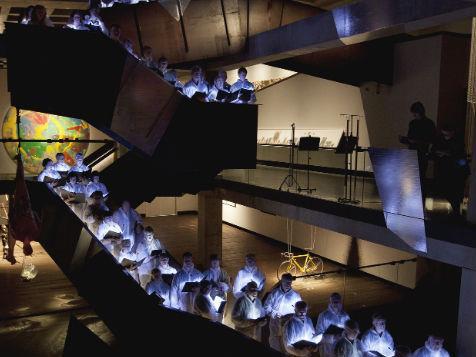The Tasmanian Symphony Orchestra Chorus perform works by Whitacre, Part, Ligeti, Bowman and Martin on the Corten Staircase. Photo Credit: MONA/Rémi Chauvin Image Courtesy MONA Museum of Old and New Art, Hobart, Tasmania, Australia.
Four Bach chorales will be performed in complete darkness by members of the Tasmanian Symphony Orchestra (TSO) Chorus during SYNAESTHESIA+ at the Museum of Old and New Art (MONA).
TSO Chorusmaster June Tyzack said a select group of 25 chorus members would sing the chorales in the original German. The unusual setting is designed to give visitors an opportunity to ‘hear’ music without ‘seeing’ it.
‘MONA itself is such a visual place, and the whole idea of synaesthesia in itself – where people “hear” sounds as colours – The experience will be quite exhilarating. What I wanted to do is take that sense away and heighten the other senses, so that people could experience this music without seeing anything.
‘This all came of some research I was doing around audience behaviour, and it seemed to me, in the concert hall the audience member is completely and utterly passive, and yet distracted by other people in the audience,’ she said.
Performed in the famed Barrel Room, Black Bach forms just one segment of the greater SYNAESTHESIA+ program, a two-day immersive event that seeks to conceptualise the phenomenon of synaesthesia through music, light and food.
Tyzack said that the ‘colour’ of the music within the performance would recontexualise the chorales from their traditional home within a church environment. ‘For anyone hearing these chorales in a church, there would be this overlay of colour, which would fluctuate with the sun, the moon – whatever. This colour would penetrate the music. I want to take all of the colour away, so that we’re just left with the sound of it.
‘What Bach has done is harmonised it in four different ways. For some people they will hear these differences because there’s nothing else to distract them,’ she said.
Black Bach forms just one aspect of the TSO Chorus program during SYNAESTHESIA+, which includes pieces by Scottish composer Scott McMillan. ‘We’re also doing a piece by a Norwegian composer Knut Nystedt. His piece Immortal bright takes a Bach chorale and we have members of the chorus singing it at five different speeds. It’s extraordinary dissonance on the works of dispose, death and freedom,’ she said.
Held in mid August, SYNAESTHESIA+ returns to MONA following a successful 2012 instalment as a total saturation of senses. ‘Every aspect of it was thrilling. There were unexpected performances happening throughout the museum. Everything was colourful. It was a great expression of music, sound and colour,’ said Tyzack.
SYNAESTHESIA+ will be held at the Museum of Old and New Art on Saturday 16 August and Sunday 17 August, 2014.
For bookings and further information visit the MONA website.





